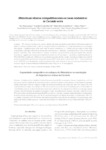Please use this identifier to cite or link to this item:
http://www.alice.cnptia.embrapa.br/alice/handle/doc/490380| Title: | Rhizobium strains competitiveness on bean nodulation in Cerrado soils. |
| Authors: | RAPOSEIRAS, R.  MARRIEL, I. E.   MUZZI, M. R. S   PAIVA, E.   PEREIRA FILHO, I. A.   CARVALHAIS, L. C.   PASSOS, R. V. M.   PINTO, P. P.   SÁ, N. M. H. de   |
| Affiliation: | IVANILDO EVODIO MARRIEL, CNPMS; ISRAEL ALEXANDRE PEREIRA FILHO, CNPMS. |
| Date Issued: | 2006 |
| Citation: | Pesquisa Agropecuária Brasileira, Brasília, v. 41, n. 3, p. 439-447, 2006. |
| Description: | ABSTRACT: The objective of this work was to identify the most competitive and effective Rhizobium strains in order to increase common bean yield by nitrogen fixation as alternative or complementation to the nitrogen fertilization. Competitiveness tests were lead in axenic conditions, in Cerrado soil pots and in three field experiments, with native Rhizobium strains that were previously identified, according to their effectiveness and genetic variability. The identification of strains in nodules was performed using serological tests (axenic conditions) ? agglutination and enzyme linked immunosorbent (Elisa) assays ? and random amplified polymorfic DNA (RAPD) (Cerrado soil). Plant yield was determined using the dry weight (greenhouse conditions), total N and grain yield (field experiments). Among the analyzed Rhizobium strains, native strain SLA 2.2 and commercial strain CIAT 899 were the dominant nodules in plants of the most productive plots, presenting yield productivity similar or higher to those obtained in treatments where 20 kg ha-1 of N were applied. RESUMO: O objetivo deste trabalho foi identificar as estirpes de Rhizobium mais efetivas e competitivas, a fim de maximizar a produtividade do feijoeiro por meio da fixação de nitrogênio, como alternativa à adubação nitrogenada. Foram conduzidos testes de competitividade em condições axênicas, em vasos com solo do Cerrado e em três experimentos de campo, com estirpes de Rhizobium nativas, previamente selecionadas quanto à efetividade e à variabilidade genética. A identificação das estirpes nos nódulos foi efetuada por meio das técnicas de aglutinação e ensaio imunoabsorvente de ligação de enzimas (Elisa), em condições de casa de vegetação, e pela técnica de DNA polimórfico amplificado ao acaso (RAPD), em solo de Cerrado. A produtividade das plantas foi determinada pela produção de matéria seca, teor de N e produção de grãos (condições de campo). A estirpe nativa SLA 2.2 e a estirpe comercial CIAT 899 foram dominantes nos nódulos das plantas das parcelas mais produtivas, com índices de produtividade iguais ou superiores aos obtidos nos tratamentos em que foram aplicados 20 kg ha-1 de N. |
| Thesagro: | Elisa Phaseolus Vulgaris |
| Keywords: | Ocupação nodular RAPD |
| DOI: | 10.1590/S0100-204X2006000300010 |
| Type of Material: | Artigo de periódico |
| Access: | openAccess |
| Appears in Collections: | Artigo em periódico indexado (CNPMS)  |
Files in This Item:
| File | Description | Size | Format | |
|---|---|---|---|---|
| Rhizobiumstrains.pdf | 1,44 MB | Adobe PDF |  View/Open |









